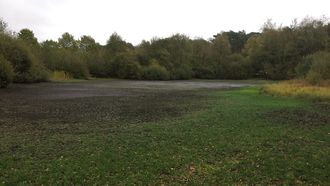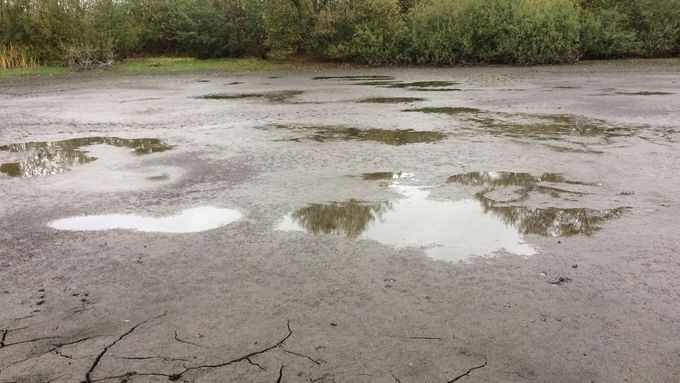Die Arbeiten im trockengefallenen Heideweiher im November 2018 © Frank Ahnfeldt, Biologische Station Kreis Paderborn – Senne
download picturemain content
Project of the month
#2/2019 KAMPETERS KOLK
Optimization of the habitat for the common spadefoot
Creation of another stepping stone to strengthen population of the common spadefoot
Due to the extreme drought in summer 2018, an action in Bielefeld’s nature reserve ‘Kampeters Kolk’ was included within the framework of the LIFW IP ‘Atlantic Region DE’ in cooperation with the Biological Station Paderborn - Senne and the Lower Nature Conservation Authority of the City of Bielefeld.
With only two hectares in size, this nature reserve in the south of Bielefeld is the second smallest of the city. As early as 1932, the heath pond which is approximately 0.6 hectare in size, together with an adjacent meadow and a small alder carr, was designated as a natural monument. It had emerged by peating out a small moorland that had formed in a drainage-free depression. Even then, the nutrient-poor pond was considered a special habitat in the district of Bielefeld and had unique plant communities.
But from 1949 to the late 1960s, the legal protection provisions were little considered: hard dirt was deposited there, the alder carr was cleared and finally also the excavated soil from the development of the passing road was deposited over many years in the wetland. At the same time, cultivation in the neighbouring agriculture continued to expand.
In the early 1970s, the City of Bielefeld acquired the waters and in 1988 also the surrounding meadow. The soil deposit was removed and the waters were desludged. Various measures were taken to prevent further high nutrient input. Finally, in 1993, the area was designated as nature reserve ‘Kampeters Kolk’, with the protection target to preserve the nutrient-poor heath pond with adjacent moist meadows, sedges, reeds, willow and buckthorn bushes and their rare animal and plant species.
Kampeters Kolk is located in the immediate vicinity of the nature reserve ‘Rieselfelder Windel’. The two areas are separated by the A33 motorway, but are connected via a wildlife crossing. Therefore, the area is of great importance for bird species such as brant and white stork which use the area as a food habitat. Both areas are also known for the occurrence of the common spadefoot toad (Pelobates fuscus). Colloquially, Kampeters Kolk formerly was also referred to as "pop pond" - derived from the East Westphalian dialect vocabulary ‘Pillepoppen’ for tadpoles. However, the common spadefoot today is considered the rarest and most endangered amphibian species. In Westphalia, the toad is only very sparsely distributed; in the greater area of Bielefeld, it is only known from these two nature reserves. In the nature reserve ‘Rieselfelder Windel’, measures to promote the common spadefoot were already implemented in 2017/18 as part of the LIFE IP. Thus, a new spawning waterbody was created and in both years also animals which had been bred in captivity were released in this area.
Unfortunately, the common spadefoot population in ‘Kampeters Kolk’ – most likely due to the stocking with American sun perch – probably became extinct in the past years. In the dry summer / autumn 2018, however, the heath pond fell dry, which led to the extinction of the fish population. Thus, it was possible to desludge the heath pond very cheaply and undisturbed due to the sandy and bearing soil with excavator, wheel loader and tractor with trailer, and thus to further improve the situation for reproduction for the common spadefoot. The mud layer on the ground was subtracted and temporarily stored in the bank area at the access. After an investigation of the soil samples which is necessary for the further whereabouts, the excavated material shall be removed as fast as possible.
By optimizing the waterbody, a further stepping stone was created to strengthen and increase the common spadefoot population in this area. In addition to extensive optimization measures on the water's edge and in the surrounding area, the reintroduction of the common spadefoot is planned for the second phase of the project.





